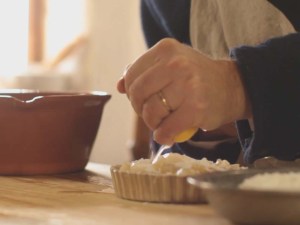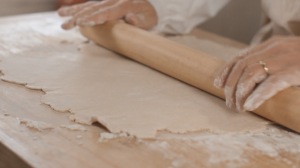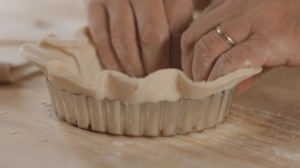I’ve mentioned in an early post that there were, for the most part, three types of pastry crusts used in 18th century cooking. This is admittedly a simplification of the goings-on of the old English kitchen. There were other types of crusts, but the three most commonly used in recipes were the standing crust, the puff paste, and the short paste. Of these three, the short paste, also known as the common paste, was the most recent development in 18th century pastry.
The short paste is a light and flaky pastry — both the ancestor and equivalent to our modern pie crust. It consists of flour, fat, and just enough water to hold it together. Salt was sometimes tossed in, sometimes sugar. Contrary to the tough standing paste which relied on boiling water and butter to be study enough to be used as baking dish, serving dish, and storage dish alike, a short paste’s light and flaky (and very edible) success relies on the ingredients being cold.
Now I refuse to step here into the modern war of words pertaining to which is best to use in a pie crust: butter, lard, vegetable shortening, or some combination thereof. In every case that I am aware, 18th century recipes called for the use of butter. So that’s what we’re “sticking” with. [Sorry. I couldn’t resist.]

Here’s a typical recipe for short paste. You can see this recipe demonstrated in our video below. This recipe is perfect for a single crust for a 8″ to 9″ pan (and you can possibly squeeze a second crust out of it if you recycle your scraps), or it will be more than adequate to cover a 5″ tart tin, both top and bottom.
A Short Paste Recipe
Ingredients:
2 cups Flour (All Purpose will do)
12 Tablespoons Butter, chilled
3 -5 Tablespoons Cold Water
Also:
Additional Butter for the Baking Tin
Directions:
Cut your butter into pieces and combine it with the flour in a large bowl. If you’re working at home, you can use a pastry cutter or a food processor, otherwise use a large spoon to press the butter into the flour, or use your fingertips to squeeze it in. If you use your fingers, try to avoid being in contact with the butter any longer than is absolutely necessary. You want to work the flour and butter together without melting the butter, and even the temperature of your hands can melt it.
When you’re done, the mixture should look mealy like corn flour.
Next add just enough water to bring the dough together.
Gather your dough, and roll it out on a well-floured surface with a well-floured rolling pin, rotating the dough to keep it from sticking to the work surface. Roll it out until it’s about 1/8″ thick.
Cut out two circles, about 2″ to 3″ wider in diameter than the pan you intend to use.
Press the dough into a well-buttered tin, making sure it is pressed well into the corners. Trim off any excess dough.
And now for the filling…
Here’s a delicious recipe from Hannah Glasse in her 1760 cookbook, “The Compleat Confectioner.” Similar recipes are offered in numerous other period cookbooks.
Here is a bit more precise take on Glasse’s recipe, good for our 5″ tart tin:
Pear Tart
Ingredients:
2 Ripe Bosc Pears, pared, corred, and cut into pieces
4 Tablespoons Powdered Sugar, divided
1 strip of Lemon Rind, about 3″ long
1 teaspoon fresh Lemon Juice
Directions:
You can bake your empty bottom crust in a medium oven, 400-degrees (F), for 5 to 10 minutes if you wish (but you don’t have to). Doing so will ensure the bottom crust is completely baked.
Sprinkle 2 Tablespoons of powdered sugar into your empty pastry crust (after baking it if you so choose to do so) and set it aside.
Place your chopped pears into a sauce pan and pour in just enough water to cover. Set this over a low fire and simmer until the pears are very soft.
Once the pears are soft, drain the pears, reserving the liquid. Allow the pears to cool slightly before filling your pie crust with pear pieces.
Sprinkle an additional 2 Tablespoons powdered sugar on top of the pears.
 Drizzle a Tablespoon of the pear liquid on top of the pears, along with a squeeze of juice from half a lemon.
Drizzle a Tablespoon of the pear liquid on top of the pears, along with a squeeze of juice from half a lemon.
 Cover the pie with a top crust, trim away any excess paste, and cut a few vents in the top. Bake in a 400-degree oven for about 20 to 30 minutes, or until golden.
Cover the pie with a top crust, trim away any excess paste, and cut a few vents in the top. Bake in a 400-degree oven for about 20 to 30 minutes, or until golden.
Optional toppings for your tart:
There are a number of period-correct ways of topping your tart. The tart at the top of the page was brushed with a wash of beaten egg whites and then sprinkled with sugar. Maria Rundell suggests this general approach to tarts in her book, A New System of Domestic Cookery (1807, page 165).
Another approach is to bake the pie until it’s done, bring it out of the oven to cool slightly, then top with a meringue of egg whites and sugar. You will want to then pop it back into the oven (250 – 300-degrees) until the meringue sets, but preferably does not brown. Topping double-crusted tarts with meringue or chiffon was apparently a common practice, as that technique was mentioned in numerous period cookbooks. Here’s such a recipe from Mrs. Frazer’s book, “The Practice of Cookery,” (1791, page 205).
There is debate about the timing of the meringue’s application. Other cookbooks frown upon a meringue that is browned. In order to achieve a white meringue and an adequately baked pie, the pie must be baked first and then baked again with the meringue.
A Third way of topping your tart is with what Mrs. Frazer refers to as a “liaison” or a custard. Farley recommends this topping as well in his book “The London Art of Cookery,” (1783, page 209) The following recipe for “a Plain Custard” can be found in his book on page 317:











Hi, You have wonderfully explained the recipe. I just hope I get a chance of making them.
Pingback: The Christmas Pie | Savoring the Past
Thanks for the great videos, and documentation to back up these recipes. I got inspired to make pear tarts after reading and watching. They turned out yummy
Pingback: A Pork Pie with a Standing Crust | Savoring the Past
Pingback: The Crust of Time | Savoring the Past
Pingback: A Large Standing Crust | Savoring the Past
Pingback: Currant Challenges | Savoring the Past
Could you redo this recipe for an eight inch pie plate? Or should I just double the recipe?
If you add half again as much of each ingredient, you should have more than enough for an 8″ pan.